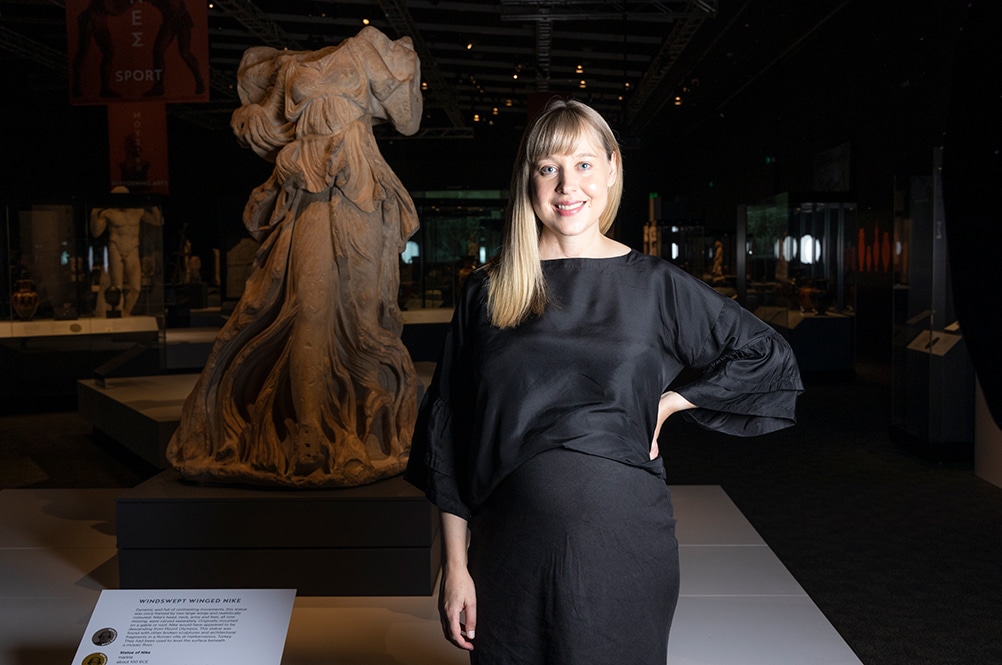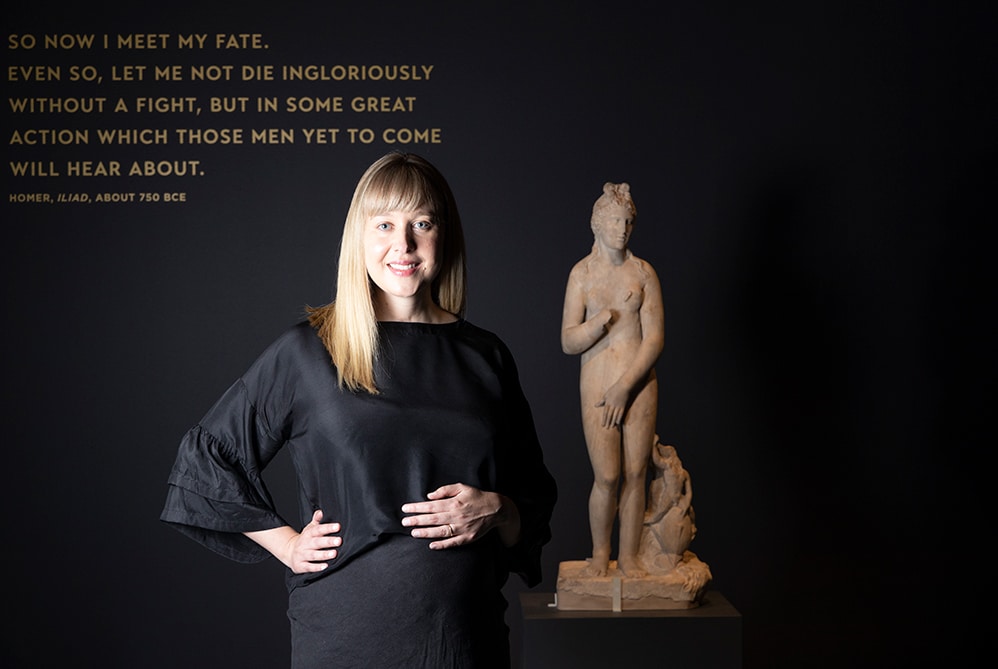It was a Herculean task for National Museum of Australia curator, Dr Lily Withycombe, and the wider team working on Ancient Greeks: Athletes, Warriors and Heroes to pull together the colossal exhibition during a global pandemic.
For the past several years, Withycombe and the team worked alongside their colleagues at the British Museum, that currently claims ownership of the 178 spectacular objects that comprise Ancient Greeks.
The long-touted exhibition was supposed to open mid-2020 before finally launching some 18 months later.
It was cause for celebration when the objects finally arrived, given how complicated the pandemic made it to realise the exhibition in situ at the National Museum.
“There was serious jubilation,” Withycombe smiled. “Even the install was a very positive experience, and everyone was just really thrilled that we’d got to the point that we could open.”
If it’s all Greek to Withycombe, then consider her fluent.
Her affinity for the culture was fostered during childhood; she was gifted a book of Ancient Greek myths and quickly became obsessed with it.
“It really captured my imagination as a child, I almost thought these stories were real,” she said.
Coming to it via the classical literary tradition, while at university, Withycombe was able to expand her knowledge by studying material culture, the two combining to “fuel a great passion”.
Studying classical archaeology, she gained practical experience spending Australian winters in the Mediterranean working on excavation projects, being on the ground as mosaic floor paintings, burials and vessels were uncovered.
“You have one picture of the ancient world that’s presented through ancient texts, and then you have this other picture that’s presented through the material culture,” she said. “All of this gave me a really deep love and respect of ancient material culture.”
This exhibition’s array of artefacts ranges from grand marble statues through to objects typical of everyday life like coins, terracotta earthenware, and vases: “a whole array of material culture”.
It homes in on the theme of competition; competitive processes permeated almost every aspect of Ancient Greek life, be that war, sport, politics or performing arts.
Life was brutal and chaotic; a champion was never afforded an opportunity to rest on their laurels. In this sense, Ancient Greeks provides great insight into the psyche of the time.
“At every point you see just how competition, and this striving for excellence, but also understanding the gods had control of your fate, really pervaded every aspect of Greek life,” Withycombe said.
Given the many domains of competition almost exclusively belonged to men, Withycombe noted an interesting juxtaposition as it was the Ancient Greek goddesses who were thought to control fate.
Nike, goddess of victory, and Athena, the patron deity of Athens and goddess of wisdom and warriors, feature prominently throughout the exhibition in many forms: from exquisite marble sculpture and vases through to common coins, and terracottas.
How did women live in Ancient Greece?

So, what does Ancient Greeks tell us about how women lived?
“It can be really hard for us to untangle,” Withycombe said. “The great source bias is that the sources and even artistic traditions, they were all created by men.
“But there are so many objects in the show that give us this fascinating glimpse into the role of women in Ancient Greece.”
A hydria depicts a woman spinning, making clothes. In front of her stands her husband with a staff on his hand and a wreath on his head, which suggests he was about to leave for a party while his wife stays at home.
“I love the contradiction in that scene,” Withycombe said.
Another vase shows a mother giving her baby to a nurse maid, while her husband stands to the side watching on.
“It’s a really fascinating insight into female domesticity,” she said.
A terracotta piece portrays two young women playing with knucklebones, most likely playing something known as “the Aphrodite throw”.
“It shows these women playing this game of chance, probably trying to work out if they were going to get married, what their husband was going to be like. Young women were meant to be addicted to knucklebones,” Withycombe said.
A beautiful marble statue offers a Hellenistic portrait of a young woman covered in “exquisite, thick, heavy drapery” – the finest materials in the Mediterranean at the time.
Amazons, a mythical race of warrior women from beyond the known world, are presented on a block from a podium frieze from the Mausoleum at Halicarnassus.
“Everything they do is set in opposition to the ideal Greek woman,” Withycombe said. “They spurn the company of men, they don’t want children, they’re meant to cut off one of their breasts.”
For that reason, Withycombe believes Amazons hold a “really fascinating place and role in Ancient Greek imagination”.
“Whether or not they serve as purely the anti-type of a woman to reinforce the stereotype, or they’re tapping into something that there was maybe this awareness that beyond the Greek world there were different ways of living, we don’t really know,” she said.
Ancient Greeks: Athletes, Warriors and Heroes is on display at the National Museum of Australia until 15 May 2022; click here for more.
Get all the latest Canberra news, sport, entertainment, lifestyle, competitions and more delivered straight to your inbox with the Canberra Daily Daily Newsletter. Sign up here.



